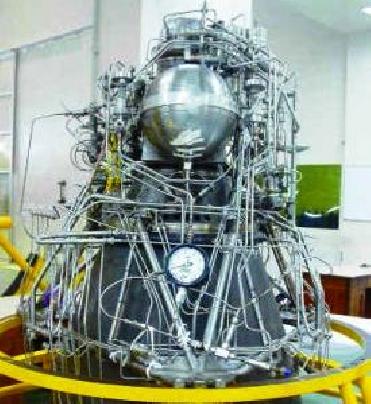
Cryogenic engine built by ISRO. A file photo.
BANGALORE (PTI): India is set to launch in a month its powerful rocket with the homemade cryogenic engine to propel a satellite into a geosynchronous orbit and become only the sixth nation to develop this complex engine.
The much awaited launch has been billed as a landmark event for the country's space programme after its maiden unmanned moon mission Chandrayaan-I in 2008.
India had been using Russia-made cryogenic engines so far for satellite launchings. A cryogenic engine will be used for the first time in the rocket's upper stage.
Indian Space Research Organisation(ISRO) is getting ready for the launch of the Geosynchronous Satellite Launch Vehicle (GSLV) from the spaceport of Sriharikota expected on April 15, an ISRO source told PTI. A geo-stationary orbit is about 36,000 km above the earth.
"The launch is likely to be on April 15 or before April 20. Preparations are underway", the source said, adding "The exact date of the launch will be finalised at the mission readiness review in Sriharikota on Sunday".
With the launch, India would join a select club of five nations--U.S., Russia, China, Japan and Israel--that had mastered the complex cryogenic technology. The mission would make New Delhi totally self-reliant in all aspects of launch vehicle technology 15 years after work was started on developing the cryogenic technology.
It would be the first time that ISRO would launch a GSLV with indigenous cryogenic engine, a programme that was taken up in 1996 following the technology denial regime in the 1990s. The US had then forced Russia to stop giving India the technology.
ISRO's previous GSLV flights carried Russian cryogenic engines procured earlier. Next month's GSLV would carry GSAT-4, a 2,200 kg technology demonstrator satellite.
Also for the first time, ISRO would test the electric propulsion technology -- plasma thrusters -- that Indian space scientists developed, in GSAT-4, in addition to chemical propulsion that it had been using.
According to ISRO officials, the electric propulsion technology is expected to boost the life of geostationary satellites by upto five years.
"This is a concept we are going to prove in this (GSAT-4). Once proven, it can be adopted as standard for future geostationary orbits", an ISRO official said.
Technological challenges faced during the development of indigenous cryogenic engine and stage include those relating to new materials, composite thermal insulation, new fabrication techniques, handling of cryogenic fluids at cryogenic temperatures, realisation of facilities for assembly, integration and testing, and associated safety systems, ISRO officials said.
 Next Article
Next Article













The Indian Air Force, in its flight trials evaluation report submitted before the Defence Ministry l..
view articleAn insight into the Medium Multi-Role Combat Aircraft competition...
view articleSky enthusiasts can now spot the International Space Station (ISS) commanded by Indian-American astr..
view article